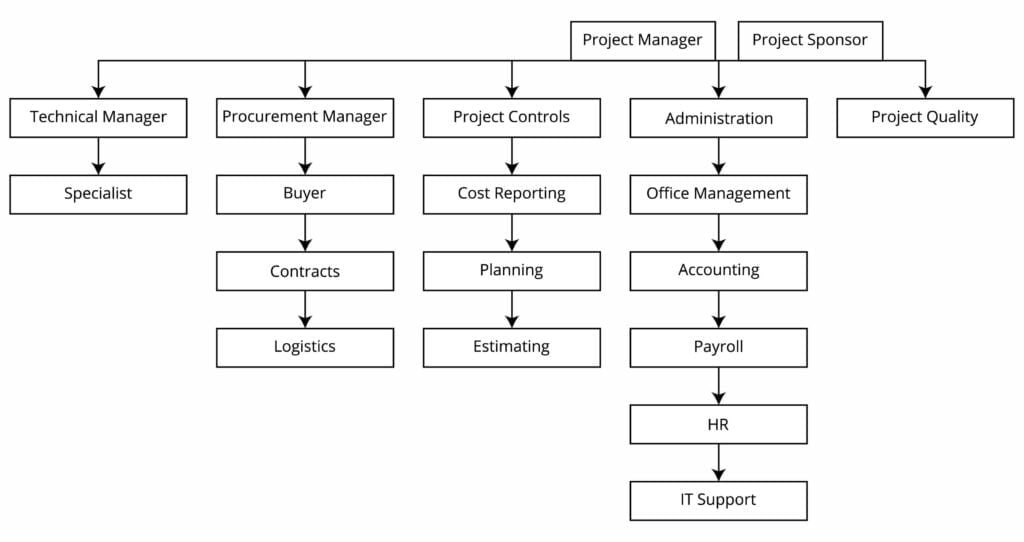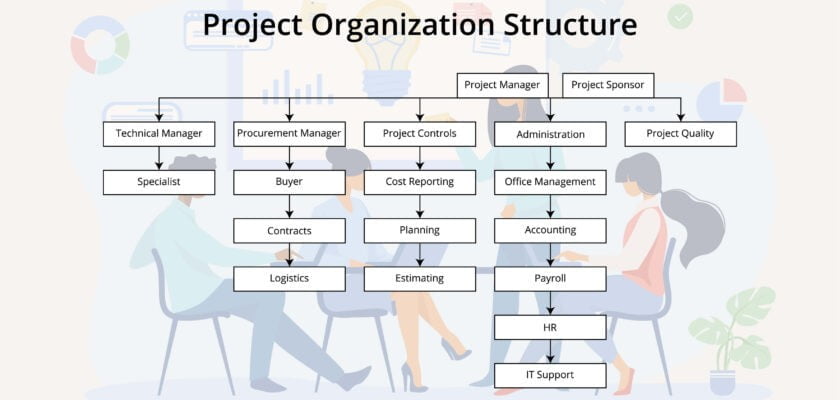The project does not have a single organizational structure. The project organization structure is established according to the type of project. All project structures are designed in such a way that project activities can be completed efficiently and effectively.
What is Project Organization?
A project organization is a framework that makes coordinating and carrying out project tasks easier. Its principal purpose is facilitating interactions among team members with the least disruptions, overlaps, and conflict. The type of organizational structure employed for the project is an essential choice in project management.
And project management organizational structure establishes the hierarchy and authority of those participating in a particular project. On a chart, the structure specifies each team member’s function and the reporting lines for team members to refer to during a project.
Project Organization Structure
Each project is unique, and the design of project organization structture should consider the organizational environment, the project characteristics in which it will work, and the amount of power assigned to the project manager. A project structure can take many different shapes, each with its own set of pros and cons.
One of the key purposes of the project organization structure is to reduce the uncertainty and misunderstanding that typically occurs at the project’s initial phase. The structure describes the interactions among project management members as well as the ties with the outside world.
A properly designed project organization structure is essential to project success. The organizational structure of a general project is presented below –

- Project Sponsor: The project entrepreneur does not perform the day-to-day functions of the project. Entrepreneurs provide project resources and remove project barriers. The initiator of the project plays the role of the leader of the parent organization. The entrepreneur performs all the tasks including providing project input, information, and guidance for the project’s success. The success of the project depends on the collaboration of the project entrepreneur.
- Project Manager: The project manager is the chief executive officer (CEO). The project manager decides on staffing, asset allocation, and work processes to get the project started quickly. Moreover, the project manager gives the technical team important directions to complete the work. The project technical team leader performed his duties in the light of the project manager’s direction. In a word, the project manager completes all the tasks to complete the project successfully.
- Project Control: The project controller is an important part of the project planning by which the progress of the project is carried out as planned. Project Control provides important information about other activities of the project and the project manager evaluates the project cost schedule by analyzing all this information. Expenditure reporting, planning, budgeting, etc. are included in the project control functions. Project control functions are as follows –
✦ Budget formulation
✦ Gain an idea of project dynamics analysis and project future
✦ Planning and scheduling
✦ Adapt to change
✦ Measurement of project progress as per schedule etc.
The project control team collects information on various tasks, prepares reports, and provides them to each task manager. From that report, it is known whether the progress of the project has been as per the project plan. Above all, the project control manager coordinates all the tasks and performs the project control work smoothly. - Project Procurement: To complete the project, one has to procure supplies and machinery and equipment. In some projects a specific person is given the responsibility to carry out the collection work properly. He buys product materials. Arranges purchase agreements, arranges for the installation of new equipment and tools, and arranges training to introduce new technologies as needed. What is needed for the project? When needed? The person in charge of the collection Informs the project manager about this. The person in charge of the collection plays an important role in the decision making regarding the input and scheduling, and scheduling of the project. All in all, the person engaged in the collection work of the project provides the right products and equipment at the right place at the right time, that is, with logistical support.
- Technical Management: The main task of technical management is to observe the technical aspects of the project. The project needs to apply new technologies and make arrangements to address technological challenges. Apart from that, introducing new technology to the staff is one of the major tasks of this department. In the case of high technology, many times an expert is hired who advises the technical manager about the new high technology.
- Project Quality: In the case of small-scale projects, the quality of the project is entrusted to the technical department of the project. However, in the case of large projects, there is a separate department to look after the quality of the project, and its responsibility is entrusted to the project quality manager. The main responsibility of the quality manager is to ensure the quality of the project process but not the quality of the buyer’s product. This means monitoring the quality of work at each level of the project. It is not the responsibility of the project quality manager to ensure the quality of the vehicle produced in such a car manufacturing project. The quality manager will see to it that every task at every level of the car manufacturing project is done in a quality manner. The product quality department will see the product quality i.e. the quality of the car.
- Project Administration: The main responsibility of the administrative department of the project is to assist in the implementation of the project by completing the administrative tasks properly. The main administrative functions of a project are as follows –
✦ Accounting services
✦ Legal services
✦ Asset management
✦ Human resource management
✦ Other ancillary functions
Most of the above administrative functions of the organization are performed by the parent organization. For example – the parent organization assigns an employee from its HR department to the HR department of the project who makes the salary, benefits, HR policy of the employees engaged in the project. In addition, the main organization provides accounting and assistance for the project. However, in the case of large projects, there is a separate administrative department and all the administrative work of the project is entrusted to the administrative manager of the project. The Administrative Manager completes the administrative tasks of the project by liaising and coordinating with the parent organization.
In general, the project’s work is completed from beginning to end according to the Project Organization structure. The concerted efforts of each department are required for the smooth completion of the project.

